
Kenai Peninsula Borough is a borough of the U.S. state of Alaska. As of the 2010 census, the population was 55,400. The borough seat is Soldotna.
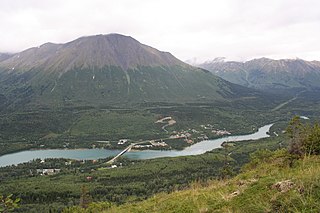
Cooper Landing is a census-designated place (CDP) in Kenai Peninsula Borough, Alaska, United States, about 100 miles (160 km) south of Anchorage, at the outlet of Kenai Lake into the Kenai River. The town was first settled in the 19th century by gold and mineral prospectors, and has become a popular summer tourist destination thanks to its scenic location and proximity to the salmon fishery of the Kenai River and Russian River. As of the 2010 census, the population in Cooper Landing was 289, down from 369 in 2000.

Seward is an incorporated home rule city in Alaska, United States. Located on Resurrection Bay, a fjord of the Gulf of Alaska on the Kenai Peninsula, Seward is situated on Alaska's southern coast, approximately 120 miles by road from Alaska's largest city, Anchorage.
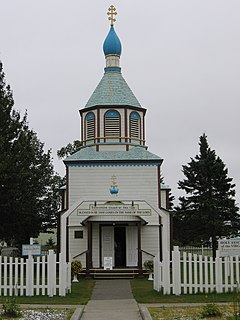
Holy Assumption Orthodox Church, also known as Church of the Assumption of the Virgin Mary, is a Russian Orthodox parish church in Kenai, Kenai Peninsula Borough, Alaska, United States. Completed in 1896, it is the oldest-standing Russian Orthodox church in Alaska and was a major center for the assimilation of the local Native population. It was declared a National Historic Landmark in 1970 and was added to the National Register of Historic Places shortly after.

St. Peter's Episcopal Church is a historic Episcopal church located at 239 Second Avenue at Adams Street in Seward, Alaska, United States. The first Episcopal services in Seward were held in 1904 by a priest from Valdez. The church building was constructed between 1905 and 1906 and was consecrated on April 1, 1906 by the Rt. Rev. Peter Trimble Rowe, the first bishop of the Episcopal Diocese of Alaska. The interior of the church is noted for the 1925 reredos of Christ's Resurrection and Ascension which was done by Dutch artist Jan Van Emple.

The following outline is provided as an overview of and topical guide to the U.S. state of Alaska:

The Holy Transfiguration of Our Lord Chapel is a historic Russian Orthodox church located near Ninilchik, Kenai Peninsula Borough, Alaska, that was built in 1901. It is an approximately 20-by-50-foot roughly cruxiform-shaped building, mainly designed by Alexi Andreev Oskolkoff who came from Sitka to supervise the building's construction. The 1901 church replaced an older church built near Ninilchik village's 1846 founding. As of 1977, the church competed only with a largely altered schoolhouse as an artifact of past Russian associations to the community.
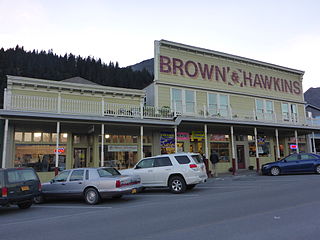
Brown & Hawkins is a general store in Seward, Alaska. It was founded in 1904 to serve the town and those constructing of the Alaska Central Railroad, and has been the oldest continuously operating business in Seward. It was listed on the National Register of Historic Places in 1988. It was announced in 2013 that the owners were retiring without finding anyone to buy their business.

The Lowell Creek Diversion Tunnel is a flood control project located in Seward, Alaska, United States. The project was constructed to alleviate flooding of Lowell Creek in Seward. It was the first flood control project completed by the United States Army Corps of Engineers in Alaska.
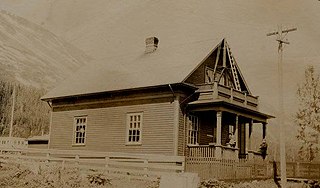
The Government Cable Office in Seward, Alaska, United States, is a historic building that served as a telegraph office that connected Seward with communications in the rest of the United States.

The Seward Depot, also known as the Seward Station, is a former rail depot in Seward, Alaska, United States.

The Jesse Lee Home for Children was a former home for displaced children on Swetmann Avenue in Seward, Alaska, United States. It was operated by the United Methodist Church from its opening in 1926 until the building suffered damage from a 1964 earthquake and operations were relocated to a new building in Anchorage.

Alaska Central Railroad Tunnel No. 1, also known as the Loop District Tunnel No. 1 is a historic railroad tunnel located about 40 miles (64 km) north of Seward, Alaska, in the Placer River Valley, Kenai Peninsula. The tunnel was dug in 1906 and served the Alaska Central Railroad and later the Alaska Railroad until the route in the area, known as the "Loop District" was rerouted in 1951.

The Ballaine House is a historic homestead in Seward, Alaska, United States. The home was built in 1905 by prominent Seward businessman Frank Ballaine. Frank was the brother of John Ballaine, who is considered the founding father of Seward. The building currently houses a bed and breakfast.
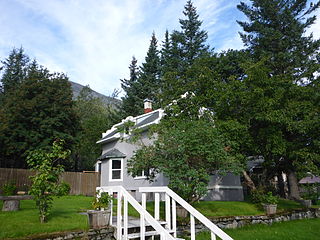
Swetman House, also known as Swetmann House and Gerhard "Stucco" Johnson House, is a historic residence at 325 5th Avenue in Seward, Alaska. The house was constructed in 1916 and was originally located adjacent to Seward's Mount Marathon. In 1920 or 1921, the original owner, Gerhard "Stucco" Johnson, sold the house to pharmacist Elwyn Swetman on condition that Swetman move the property to his own lot. The property was added to the National Register of Historic Places on February 17, 1978.

Hoben Park, also known as Arcade Park, Nile Park and Ladies Park, is a city park on the waterfront of Seward, Alaska. It is bounded by the Alaska Sealife Center, the Seward Depot, Railroad Avenue, and Resurrection Bay. The park's north and west sides have a decorative concrete wall, part of which is original to the park's 1923 construction date. The park has been generally restored to its 1920s appearance, although the north side has been shortened due to road widening. Construction of park formed a major part of the city's self-promotion as the "Gateway to Alaska", and was timed to be finished in time for the visit to the city by President Warren G. Harding on July 13, 1923, when completion of the Alaska Railroad was celebrated. The park is named for Hedley V. "Harry" Hoben, a prominent local citizen who was mayor in 1918–19. Hoben promoted the park and paid for its maintenance until his death in 1948.

The Cooper Landing Post Office, formerly known as Jack Lean's Store, is a historic building located in the town of Cooper Landing, Kenai Peninsula Borough, Alaska. Cooper Landing was established after prospector Joseph Cooper discovered gold in the 1880s where the Kenai River meets Kenai Lake. The chalet-style building was built c. 1910-20 as a simple log cabin, and was enlarged in the 1920s and 1930s, probably not acquiring its distinctive facade until the 1930s. Its facade is adorned with hunting trophies such as caribou and moose antlers. The building has been relocated a short distance to the west, along with the historical Ridderford School, and is now part of the Cooper Landing Historical Museum.

Alaska Nellie's Homestead, located at Mile 23 of the Seward Highway in Kenai Peninsula Borough, Alaska, is the former homestead of Nellie Neal Lawing. Neal Lawing had migrated to Alaska in 1915 and ran a number of roadhouses for the Alaska Railroad before settling at the Roosevelt roadhouse on Kenai Lake in 1923, where she built her homestead. She planned to marry Kenneth Holden after settling, but he died in an industrial accident before their marriage; his cousin Billie Lawing then proposed to her, and the two married. A post office opened in the area in 1924; Nellie was the first postmistress, and the post office was named Lawing in her honor.

The Hope Historic District encompasses the surviving elements of the former mining boom town of Hope, Alaska. Hope is located in the northeastern corner of the Kenai Peninsula, alongside the spot where Resurrection Creek empties into the Turnagain Arm of Cook Inlet. Principal access to Hope is via the Hope Highway, a side road of the Seward Highway. Its historic center is formed by a grid of streets with Main Street at the west and Fifth Street at the east, A Street at the south, and formerly C Street at the north. The C Street area and parts of B Street are now submerged at high tide; the remaining historic buildings are located on Main, A and B streets, and First and Second streets. It includes 29 historic buildings, dating from the turn of the 20th century to the 1940s. The community was established in 1898 to support gold mining operations in the mountainous interior of the Kenai Peninsula, activity that largely ended in the 1940s. Because the town was isolated, as the Seward Highway wasn't completed until 1951, a significant concentration of its early buildings survive.

The Lauritsen Cabin is a historic miner's cabin in the Chugach Mountains of the Kenai Peninsula in south-central Alaska. It is located a short way east of mile 48 of the Seward Highway, at the confluence of Mill and Canyon Creeks. It is built of hand-hewn logs fitted tightly with dovetail notches, and features a ridge pole hewn in a curve to provide for a hip-shaped roof. The building measures about 27 by 13 feet. The cabin was built in 1896, and may have been among the first cabins built in the gold rush that swept the area in the late 19th century.






















